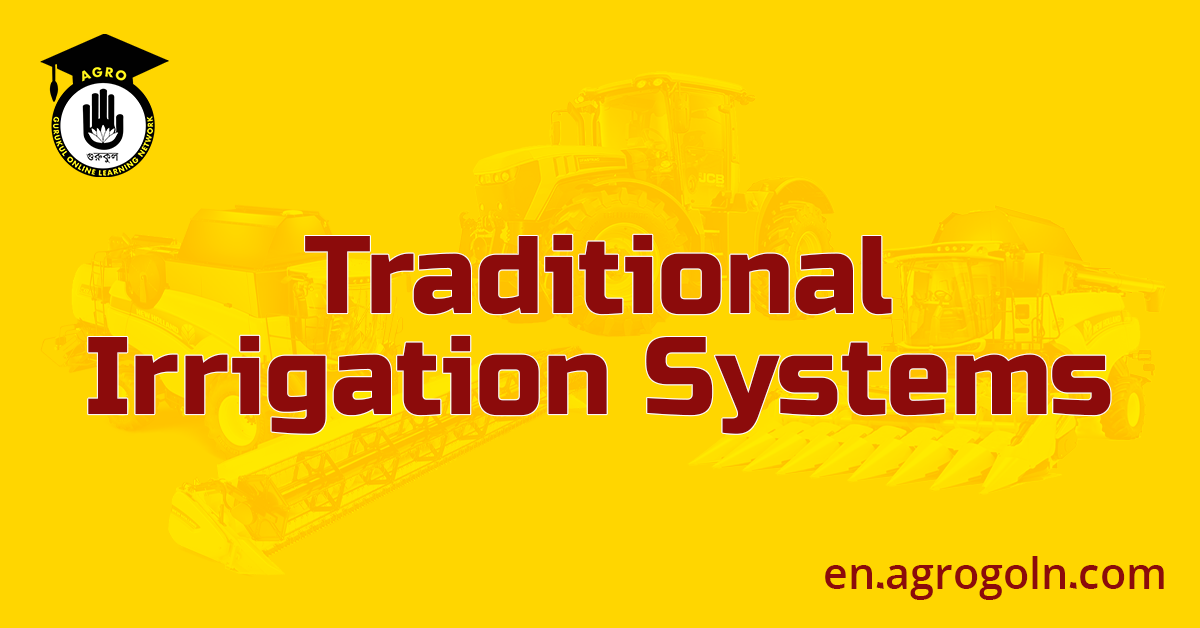Traditional irrigation systems are a testament to the ingenuity and resourcefulness of ancient civilizations. For millennia, human societies have harnessed nature’s elements to sustain agriculture and ensure the survival of their communities. From simple ditches to sophisticated networks of canals and aqueducts, these traditional irrigation systems have nourished crops and shaped cultures and landscapes. In this article, we will explore the history, principles, and enduring legacy of traditional irrigation systems around the world.
Traditional Irrigation Systems

The Origins of Traditional Irrigation
The history of irrigation dates back thousands of years, with evidence of early irrigation practices found in ancient civilizations such as Mesopotamia, Egypt, the Indus Valley, and China. These early societies relied on the regular flooding of rivers to water their crops, a practice that eventually evolved into more sophisticated irrigation methods.
The agricultural surplus enabled by irrigation was the foundation of settled communities, paving the way for the development of civilizations and cultural advancements. Ancient irrigation systems were closely tied to religious beliefs, with deities associated with water often revered as bringers of life and fertility.
The Principles of Traditional Irrigation Systems
Traditional irrigation systems are guided by principles that have been passed down through generations, often involving a profound understanding of local ecosystems, climate, and natural resources. Some key principles include:
- Water Management: Traditional irrigation systems emphasize efficient water management, making the most of available water resources. This includes capturing and storing rainwater, managing water distribution, and minimizing wastage.
- Cooperation and Community: Traditional irrigation is often a communal effort, with communities working together to maintain and operate irrigation networks. Irrigation rituals and festivals foster a sense of shared responsibility for water management.
- Terracing and Slope Farming: In regions with hilly or mountainous terrain, terracing and slope farming are used to maximize water usage and prevent soil erosion. These techniques create flat areas on slopes, allowing water to flow evenly and nourish crops.
- Crop Selection: Traditional irrigation systems are tailored to the specific needs of crops grown in a region. Some crops thrive with frequent watering, while others require more arid conditions. Traditional knowledge helps determine suitable crop choices for each area.
Types of Traditional Irrigation Systems
Over time, a diverse array of traditional irrigation systems emerged worldwide, adapted to local landscapes, climates, and water sources. Some notable systems include:
- Qanats (Karez): Found in arid regions, qanats are underground canals that channel water from aquifers to the surface. The ancient Persians are credited with developing this technology, which has sustained agriculture and communities in the Middle East for centuries.
- Hohokam Canals: Built by the indigenous Hohokam people in what is now Arizona, USA, these extensive canal systems date back over a thousand years. They allowed the Hohokam to flourish in a desert environment and support large agricultural communities.
- Polder Systems: Widely used in the Netherlands, polder systems involve enclosing low-lying areas with dikes and pumping out excess water to create arable land. This innovative method has been instrumental in reclaiming land from the sea and managing water levels.
- Chinampas: Created by the Aztecs in Mesoamerica, chinampas are artificial islands on freshwater lakes used for agriculture. These fertile floating gardens allowed the Aztecs to cultivate crops even in swampy areas.
- Acequias: Found in the Andalusian region of Spain and its former colonies, acequias are communal irrigation canals that distribute water to individual plots. The system is carefully managed by water rights and a complex set of rules.
Sustainable Practices and Environmental Impact
Traditional irrigation systems are often characterized by sustainable practices that promote harmony with the environment. For instance:
- Water Conservation: Traditional irrigation systems prioritize water conservation, reducing water waste through efficient channels, terracing, and crop selection.
- Soil Fertility: Many traditional systems rely on natural fertilizers and organic farming methods, which enrich the soil and improve its fertility over time.
- Biodiversity: Traditional irrigation fosters biodiversity by maintaining diverse crop varieties and providing habitats for flora and fauna.
- Adaptability: These systems are often adaptable to changing conditions, allowing communities to respond to environmental challenges such as droughts or floods.
Challenges and Preservation
Despite their enduring wisdom, traditional irrigation systems face numerous challenges in the modern world. Population growth, urbanization, and the intensification of agriculture have put pressure on water resources and traditional irrigation practices. Additionally, the encroachment of modern technologies and industrial agriculture can lead to the neglect and abandonment of traditional systems.
To preserve and revitalize these ancient practices, efforts are being made to recognize their cultural and environmental significance. UNESCO has designated some traditional irrigation systems as World Heritage Sites, promoting their conservation and safeguarding their knowledge for future generations.
Conclusion
Traditional irrigation systems are a testament to the profound connection between human ingenuity and the natural world. For thousands of years, communities around the globe have harnessed water’s life-giving properties to cultivate the land and sustain themselves. These systems are not just about water management; they are repositories of culture, history, and ecological wisdom.
As we confront the challenges of climate change and sustainability in the 21st century, there is much to learn from these ancient practices. Traditional irrigation systems offer valuable insights into water management, soil conservation, and sustainable agriculture. By embracing these time-honored principles and preserving the cultural heritage they embody, we can nurture the earth with ancient wisdom and build a more resilient and sustainable future.
